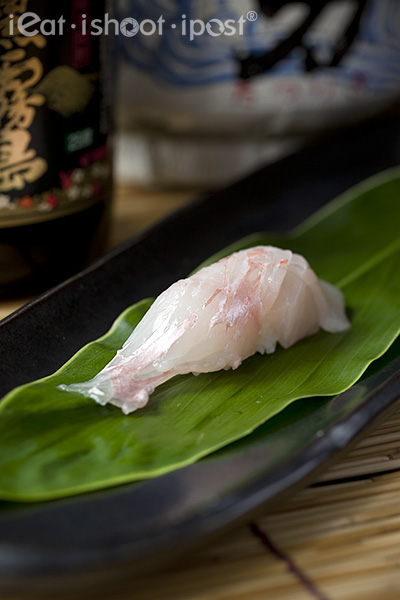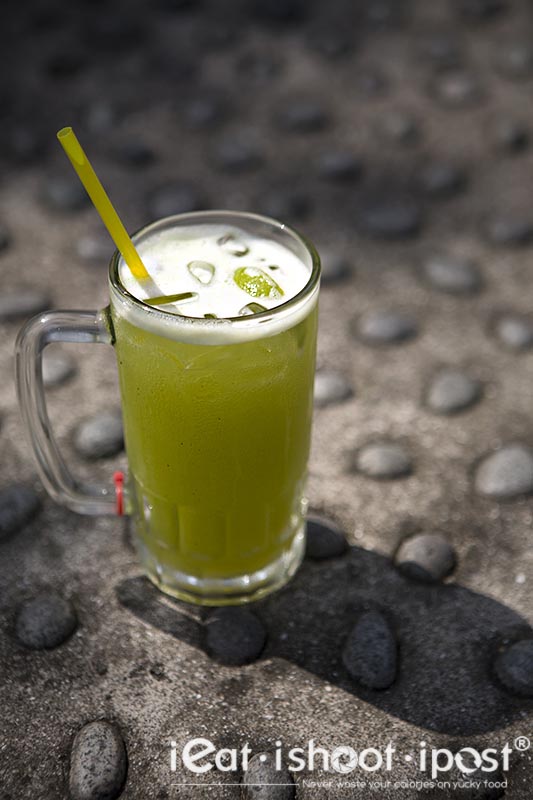The Fish
Tai is considered the most exquisite of the Shiromi dane. However there are more than 200 species of Tai but there is only one which is considered special and that is the Madai. The Japanese use the prefix “Ma” 真 which means “true” to mean the proper fish to use for sushi. Madai is very expensive in Japan because, like sharks fins, it is the one fish that should always be served during happy events like Weddings, New Year and the birth of a new baby because the name “Madai” sounds like “Medetai” which is the Japanese word for “Celebratory” and “Auspicious”. Have you ever eaten those Japanese fish shaped pancakes? Well they are called Tai yaki and they are made in the shape of the Madai.
Since Madai is the most sought after Tai in the sushi bar, it pays to make sure that the fish you are being served is a Madai rather than one of the cheaper Tais. The Madai is said to have 11 to 13 spines on the dorsal fin and there are some blue spots on the dorsal half of the fish. It is quite large, usually around 50cm. Nowadays, most of the Madai served at Sushi bars is farmed, so you can get Madai all year round. The farmed Madai look different from the wild version. It’s darker in colour and the tail is more rounded whereas the tail of the wild Madai has sharp pointed ends.

Madai, Red Sea Bream, Pagrus Major/Chrysophrys major
The Tane
Madai is one of those fish that are often used to serve as ikizukuri. That is when the fish is served with its flesh sliced into bite sized pieces and served while the mouth is still moving. When eaten ikijime (before rigor mortis) the flesh is very chewy. In Singapore we often only get to eat it nojime (after rigor mortis) so the flesh has more flavour but less chewy. Sometimes, the chef will serve it matsukawa-zukuri (pine bark) style where the skin of the fish is left on and blanched to tenderize it. The fish is first filleted and then the skin surface is covered with a piece of cloth before hot water is poured over it and the fish is then immediately cooled in ice. This causes the skin to pucker up to look like pine bark. This preserves that layer of fat under the skin which makes it more flavourful.
The Fish
This fish is easily recogized by its huge eyes and bright red colour. The name Kinmedai means “Golden Eye” Tai in Japanese and the reason the eyes are so huge is because they live in very deep water where it is very dark, so the big eyes allow more light to be detected. It is best from December to March when the fish gets very oily and tasty.
Kinmedai, Splendid Alfonsino, Golden eye snapper, Beryx splendens
Season: End Winter
The Tane
This is probably the easiest of the Shiromi-dane to recognize as it is always betrayed by its pink translucent flesh. Being a deep water fish, its flesh is oilier than the Madai and mostSushi Tsus would look out for it when it is in season.
There are more than 500 types of flat fish and even in the English speaking world their names often get confused. Halibut, Sole, Flounder are Turbot are all bottom dwelling fish which start life looking very much like a normal fish but as they mature they undergo as Salvador Dali like transformation. Some have their eyes turned towards the left side while others towards the right. The Japanese categorize the ones that face left Hirame whiles the ones that face to the right, Karei.
The Tokyo Bay used to be flourishing with these flatfish which is typically best eaten during winter when they develop a nice layer of fat under the skin. In Japan, the traditional Hirame served at good sushi bars is the Olive Flounder (paralichythys olivaceus). This fish is quite a fierce predator and has large mouth with fiercesome teeth. The expert Itamae are the ones who would be able to remove the skin while preserving that layer of fat which appears as a glistening layer while the fillet sits on top of the ice at the sushi counter.
During the Summer months Mako Garei (Marble Flounder, Pseudopleuronectes yokohamae) is served. This fish has a smaller mouth than the Olive Flounder. The flesh is also less fat during the summer months but still

In Singapore, Hirame and Karei can refer to any species of flatfish. But if you spot a sushi bar that serves Olive Flounder during winter months, then it is an indication that they are quite serious about their sushi. The sushi is usually served with just a sprinkling of salt and a dash of citrus in order to bring out the natural fresh flavour of the fish. The better sushi places might wrap the fillet with some Konbu and allow the fish to mature and develop flavour.
Now, if you have been visiting a certain Sushi Bar one day the Itamae offers you a piece of Engawa, then it shows that you have achieved a certain status in that restaurant. The Engawa is that bit of hardworking muscle next to the fins and each fish has only four strips of it, so the Itamae won’t offer it to you unless he knows you know your stuff. This tane is as prized as otoro and is considered the prime of Shiromi dane. Because it is a hardworking muscle, it is quite chewy, but the process of mastication releases glycogen from the muscles which in turn start to turn into sugars as it mixes with the saliva in your mouth. Thus the sweetness of the flesh is released. So this is a tane which you need to chew slowly to savour!
















